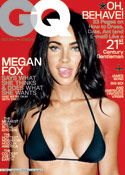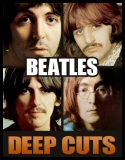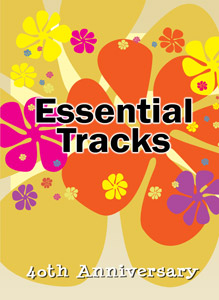
Yes, they’re songs you’ve heard a million times before. But there is a reason for that, you know: the songs were freaking amazing. It’s easy to dismiss something that seems to have been around as long as oxygen, but consider the context of these songs’ origins, and you’ll realize that what many of these musicians were doing, frankly, had never been done before. And in many cases, it would never be done again. Holler to the hippies and the funk soul bruthas.
“A Day in the Life,” The Beatles
(Sgt Pepper’s Lonely Hearts Club Band)
A 40-piece orchestra taking 24 bars to go from the lowest note on their instruments to the highest. Six people banging on three pianos at the same time in order to produce one phenomenal power chord. “A Day in the Life” obliterated every rule that ever existed for what a pop song should sound like and how it should be made, simple as that. – David Medsker
“Strawberry Fields Forever,” The Beatles
(Magical Mystery Tour)
Here is all you need to know about “Strawberry Fields Forever”: the band recorded a version by themselves in one key, and then they did a version with an orchestra in a different key. The version you know and love (you do love it…don’t you?) is both of those versions mixed together, speeding the band version up and the orchestral version down. George Martin deserved to be inducted into the Rock & Roll Hall of Fame solely for his work on this song. But as it turned out, hey, he made some other groovy tracks, too. Oh, and the flip side to the 45 of “Strawberry Fields” was a little tune called “Penny Lane,” resulting in arguably the greatest double-A-sided single in music history. – David Medsker
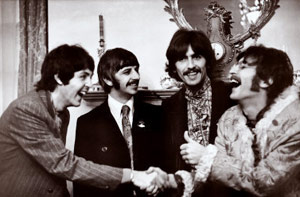 “All You Need Is Love,” The Beatles
“All You Need Is Love,” The Beatles
(Magical Mystery Tour)
We readily acknowledge that this list is top-heavy with the Fab Five, but hey, greatest band in the world, at the peak of its powers, etc. John’s latest love song to love is not his strongest, but it’s definitely his catchiest. In fact, the lyric in the verse implies a certain uselessness. “There’s nothing you can do that can’t be done / Nothing you can sing that can’t be sung…There’s nothing you can make that can’t be made / No one you can save that can’t be saved.” What, exactly, does that have to do with love being all you need? We’re still not sure, and frankly, we don’t care. Love, love, love… – David Medsker
"For What It's Worth," Buffalo Springfield (Buffalo Springfield)
Rumored to be a main motivator for Neil Young's leaving the band – his buddy Stephen Stills stole the limelight after writing the popular anthem – this song was about the closing of the Pandora's Box club on the Sunset Strip and the ensuing clash between cops and kids. But it quickly took on a larger meaning, symbolizing the generational friction happening all across the country as the hippies and flower children freaked out the authorities from coast to coast. – Mojo Flucke, PhD
“Sunshine of Your Love,” Cream (Disraeli Gears)
Playing guitar is easy: coming up with a memorable guitar riff is hard, and this song has one of the most instantly recognizable riffs in rock history. It’s not exactly Summer of Loverly, but you can’t help but think that Ginger, Jack and God heard the Who earlier that year and said, “Fuck me, we can do that!” They couldn’t, of course, but what they came up with was pretty damn cool just the same. – David Medsker
"I'm a Man," Spencer Davis Group (I'm a Man)
Written by SDG singer-songwriter Steve Winwood, this Hammond-led blues burner reached #9 on the UK singles chart. It wasn’t included on any of the band’s original albums, and it was the last hit by the Spencer Davis Group before they broke up. Winwood later went on to form the more successful Traffic, and after that, a successful solo career. Chicago’s version of this tune reached #49 on the US singles chart in 1971. – Una Persson
"Break on Through (To the Other Side)," The Doors (The Doors)
The leadoff song from the band’s first album, “Break on Through” announced a new shamanistic vision for rock n’ roll. The band was named after Jim Morrison’s desire to cleanse the world of the doors of perception that Aldous Huxley famously spoke of, and see things as they really are. “Break on Through” urged listeners to do just that. – Greg Schwartz
"Light My Fire," The Doors (The Doors)
"Break on Through" was the song that announced what the Doors were really all about, but "Light My Fire" was the smash hit that got the masses to go out and buy the album. Guitarist Robby Krieger wrote most of the song, though Jim Morrison contributed to the lyrics. The song features a timeless melody, as well as what became a controversial lyric when Morrison sang “You know that I would be a liar / If I was to say to you / Girl, we couldn't get much higher.” The radio single was chopped to the three-minute range, but listeners would get much more when they put that record on the turntable – the album version is seven minutes long and features an extended instrumental jam that reflected the band's jazzier influences. This was not your mom and dad's Top 40 single. – Greg Schwartz
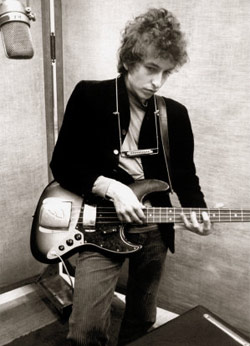 "All Along the Watchtower," Bob Dylan
"All Along the Watchtower," Bob Dylan
(John Wesley Harding)
Dylan returned from his 1966 motorcycle accident with one of his deepest cuts. The apocalyptic lyrics are inspired from several Biblical passages and reflect a generational discontent with society’s status quo, as well as what many still view as a prophetic vision of the current paradigm’s demise. Jimi Hendrix popularized the song with his 1968 cover on Electric Ladyland, which took Dylan’s sparse arrangement and turned it into a psychedelic masterpiece and Top 40 hit. Dylan himself would name Jimi’s performance as the definitive version. “Watchtower” remains one of the most covered songs of all time, as the relevance of the lyrics only continues to grow. – Greg Schwartz
“Friday on My Mind,” Easybeats (Friday on My Mind)
If you were to ask someone familiar with “Friday on My Mind” to hum a few bars, ten bucks says he starts singing the guitar line instead of the vocal. Or at the very least, he sings both vocal and the guitar line, such is the insidious catchiness of that guitar work. The Aussie band never had another hit in the States, but don’t feel sorry for co-writer George Young: his younger brothers went on to form AC/DC. – David Medsker
“Respect,” Aretha Franklin (Respect)
Listen to that first verse again: Hoo. WHATCHU WANT? Baby, I got it! Let us be clear, Miss Aretha: you had our respect from the very beginning. – David Medsker
“Ode to Billie Joe,” Bobbie Gentry (Ode to Billie Joe)
They just don’t write story-songs like this anymore. A huge #1 hit in the US, and almost as big internationally, the fictional tragic-gothic tale crossed over all the charts, spawned a novel and a movie, innumerable cover versions and no fewer than eight Grammy nominations, including four wins. – Una Persson
“Purple Haze," Jimi Hendrix (Are You Experienced?)
The whooshing sound the world heard two minutes and 52 seconds after the opening “Uhhnt” guitar lick from “Purple Haze” first dropped on radio, was the sound of a million guys running into guitar shops so they could be just like Jimi. To be honest, it’s nowhere near his best song, but it was unquestionably the right song for the moment, and that moment will live forever. Now excuse me, while I kiss this guy. – David Medsker
"Foxey Lady," Jimi Hendrix (Are You Experienced?)
While an entire generation will never be able to separate this song from a poofy-haired Garth Algar lip-synching Hendrix’ feedback-laden booty call to the girl of his dreams – in what happens to be a dream sequence – you should remember that blues guitarists had never dreamed of doing what Hendrix does here. The blues is about the soul, man, and the soul is pure, therefore the guitar sound should be clean and pure. Jimi, however, never got that memo, and thank heaven for that. – David Medsker
“Somebody to Love,” Jefferson Airplane (Surrealistic Pillow)
Talk about verses that are at odds with their chorus. “Don’t you want somebody to love? Don’t you need somebody to love? You’d better find somebody to love.” Well, sure, I might want somebody to love shortly after the time “when the truth is found to be lies, and all the joy within you dies.” Summer of Love? This is more like Summer of Death and Decay. And yet, just try to resist the urge to sing along. – David Medsker
“White Rabbit,” Jefferson Airplane (Surrealistic Pillow)
Few songs crystallize the period in which they were recorded quite like “White Rabbit.” Not from a production standpoint – though that definitely plays a part – but in the combination of the trippy arrangement with the Lewis Carroll-cribbing lyrics about the freakiest drug trip ever. Feed your head…with drugs, kids! Hey, that has to be the only explanation for why Grace Slick would go on to record “We Built This City.” – David Medsker
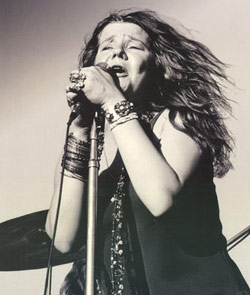 “Down on Me,” Janis Joplin/Big Brother & the Holding Company (Big
Brother & the Holding Company)
“Down on Me,” Janis Joplin/Big Brother & the Holding Company (Big
Brother & the Holding Company)
This burner was on their ’67 debut, and you can’t overlook Janis on a collection of essential tracks from the Summer of Love. – Una Persson
“I Heard It Through the Grapevine,” Gladys Knight & the Pips (Everybody Needs Love)
Their version of this classic became a #2 hit in ’67. Marvin Gaye’s rendition hit #1 in both the US and the UK the following year. Gotta have some Motown on a list like this. –Una Persson
“Alone Again Or,” Love (Forever Changes)
Perhaps the most recognizable (and leadoff) song on Love’s seminal Forever Changes, this track was written, arranged and sung by rhythm guitarist Bryan MacLean, a major force in this seminal band. Leader Arthur Lee later mixed MacLean’s lead vocal under his own harmony, but the song, like the album, are now regarded as classics. – Una Persson
“San Francisco (Be Sure to Wear Flowers in Your Hair),” Scott McKenzie (Voice of Scott McKenzie)
While McKenzie recorded the Summer of Love's unofficial theme song (written by Papa John Phillips) about the City by the Bay, ironically the record's popularity was fueled by the more business-minded L.A. crowd, according to the recent nostalgia-sodden issue of “Rolling Stone.” So while his San Francisco musician peers organically grew their popularity like typical bands – growing locally, regionally and if they were lucky, nationally – this cut got a big push from the music-biz suits and their marketing machine. McKenzie grew up with Phillips, and was invited into the Mamas and Papas when Phillips formed the group, but McKenzie declined because he wanted to strike out on his own. Whoops. – Mojo Flucke, PhD
“I’m a Believer,” The Monkees (More of the Monkees)
We’re stretching the rules a tad for this one, since it hit Number One on December 31, 1966. However, the song stayed at the top of the charts for six more weeks, and was the biggest selling single of 1967. That’s right, they even outsold the Beatles and the Stones, and while the song’s composer, Neil Diamond, continued to write and perform, he never really needed to work another day in his life after this song blew up. – David Medsker
“A Whiter Shade of Pale,” Procol Harum (Procol Harum)
Contains perhaps the most recognizable Hammond B-3 organ rock line ever, copped from Bach and perhaps a soul player or two. The vague lyrics, however, aren't very memorable, making the organ bit seem even more majestic and important. – Mojo Flucke, PhD
"Ruby Tuesday," The Rolling Stones (Between the Buttons)
One of the more melodic songs the Rolling Stones have ever released, “Ruby Tuesday” has a distinct separation between verse and chorus. The verse is melancholy and in a minor key, and the chorus lifts with major chords and soaring gang vocals. There is also a piano as well as a counter-melody flute part running throughout, giving this track a different feel from most other Stones songs. – Mike Farley
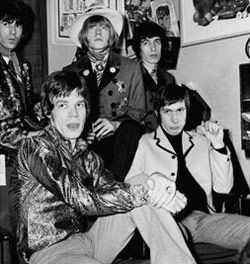 “She’s a Rainbow,” The Rolling Stones
“She’s a Rainbow,” The Rolling Stones
(Her Satanic Majesty’s Request)
Forget the vain attempt on the Stones’ part of trying to one-up the Beatles with the voices in the intro and go straight to those first seven piano notes, which are the musical equivalent of heroin. You just know that Burt Bacharach heard this and bitch-slapped Hal David for “no reason,” so angry was he that he didn’t come up with that melody first. – David Medsker
“Happy Together,” The Turtles (Happy Together)
This track can turn anyone’s mood from blue to elated in no time flat, or make any happy person feel even happier. The Turtles had a knack for melody that few artists of the current generation have, and their vocal harmonies were the equivalent of a bushel of candy canes. Go ahead: see if you can you think of one person that doesn’t like this song. – Mike Farley
"I Can See for Miles," The Who (The Who Sell Out)
The only real hit from the odd concept album The Who Sell Out, this song was the heaviest sonic blast from this proto-hard rock band yet, and perhaps the most extreme-sounding rock song ever released (at the time). Legend has it that it inspired Paul McCartney to write “Helter Skelter” after reading a review of the song (even though he had yet to hear it), in an attempt to produce an even heavier song. Those crazy Brits… – Una Persson
“(Your Love Keeps Lifting Me) Higher and Higher,” Jackie Wilson (Higher and Higher)
This song spent 12 weeks on the Top 40 singles chart, peaking at #6. Rita Coolidge had an even bigger hit with it in ’77 (reaching #2). This also helps the list from being too white. – Una Persson
“Groovin’,” The Young Rascals (Groovin’)
With its Afro-Cuban feel and mid-tempo groove, this tune became an almost-instant #1 hit and their signature song. – Una Persson
“Time of the Season,” The Zombies (Odessey and Oracle)
This one’s a flagrant cheat, since it was not released until 1969, after the band had broken up. But it was written and recorded in August 1967, and the vibe is pure SoL, baby. It is time of the season for luh-viiiiing. Bum bum bum, chick-uh ahhh. If that isn’t the most irresistible arrangement, we don’t know what is. And look at the first three lines in the second verse. “What’s your name? Who’s your daddy? Is he rich like me?” The Zombies were original gangstas, dawg. – David Medsker




